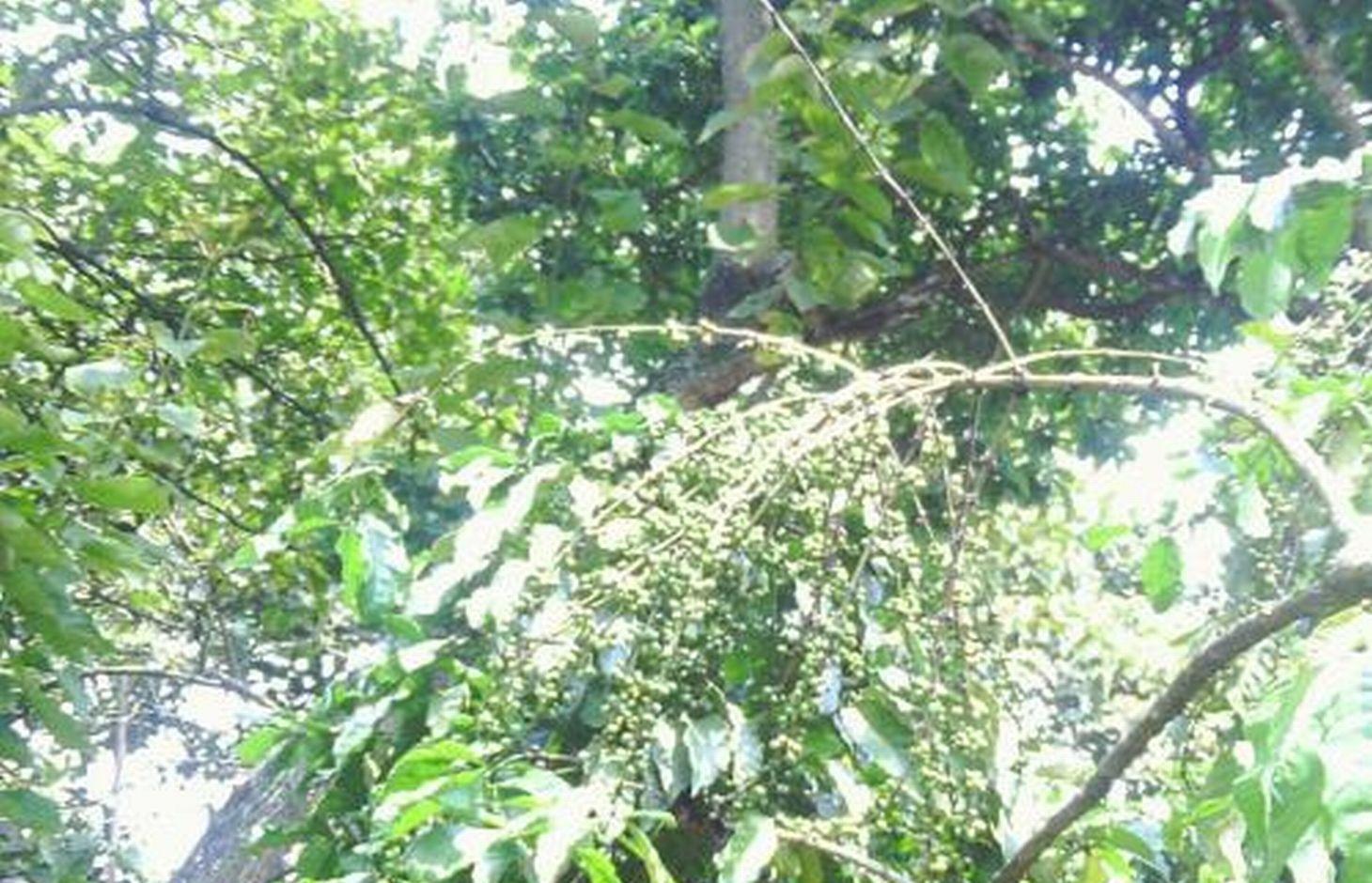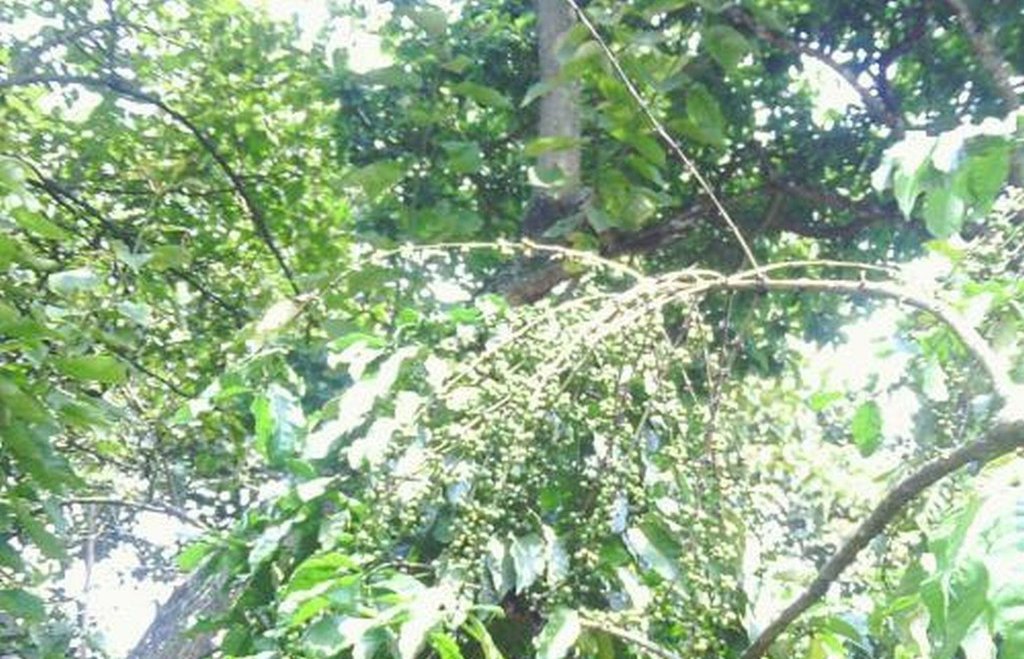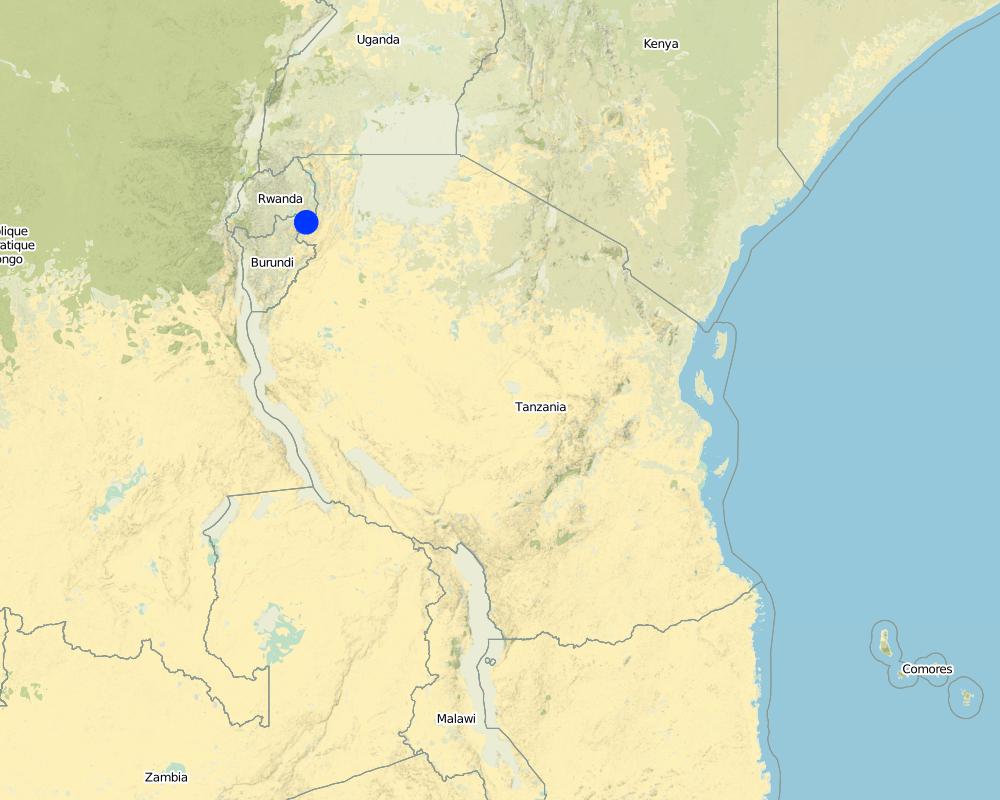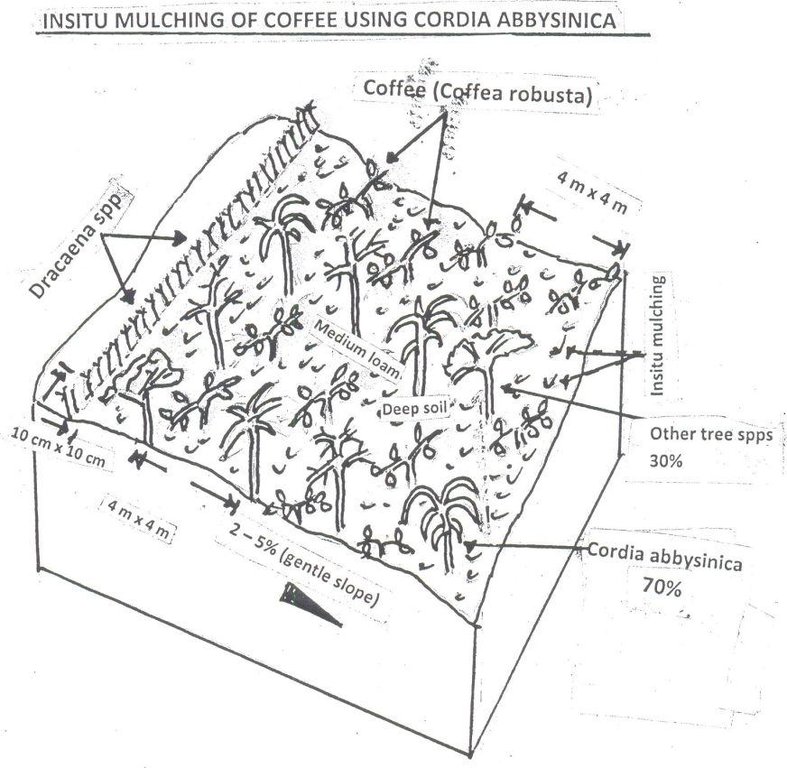In situ mulching of coffee using Cordia Abbysinica [แทนซาเนีย]
- ผู้สร้างสรรค์:
- การอัพเดท:
- ผู้รวบรวม: Bertha Munyaga
- ผู้เรียบเรียง: –
- ผู้ตรวจสอบ: Alexandra Gavilano
Kgutela igitutu ckimwani
technologies_1191 - แทนซาเนีย
ดูส่วนย่อย
ขยายทั้งหมด ย่อทั้งหมด1. ข้อมูลทั่วไป
1.2 รายละเอียดที่ติดต่อได้ของผู้รวบรวมและองค์กรที่เกี่ยวข้องในการประเมินและการจัดเตรียมทำเอกสารของเทคโนโลยี
ผู้เชี่ยวชาญ SLM:
ผู้เชี่ยวชาญ SLM:
ชื่อของโครงการซึ่งอำนวยความสะดวกในการทำเอกสารหรือการประเมินเทคโนโลยี (ถ้าเกี่ยวข้อง)
The Transboundary Agro-ecosystem Management Project for the Kagera River Basin (GEF-FAO / Kagera TAMP )ชื่อขององค์กรซึ่งอำนวยความสะดวกในการทำเอกสารหรือการประเมินเทคโนโลยี (ถ้าเกี่ยวข้อง)
FAO Food and Agriculture Organization (FAO Food and Agriculture Organization) - อิตาลีชื่อขององค์กรซึ่งอำนวยความสะดวกในการทำเอกสารหรือการประเมินเทคโนโลยี (ถ้าเกี่ยวข้อง)
FAO Food and Agriculture Organization (FAO Food and Agriculture Organization) - อิตาลี1.3 เงื่อนไขการใช้ข้อมูลที่ได้บันทึกผ่านทาง WOCAT
ผู้รวบรวมและวิทยากรหลักยอมรับเงื่อนไขเกี่ยวกับการใช้ข้อมูลที่ถูกบันทึกผ่านทาง WOCAT:
ใช่
2. การอธิบายลักษณะของเทคโนโลยี SLM
2.1 การอธิบายแบบสั้น ๆ ของเทคโนโลยี
คำจำกัดความของเทคโนโลยี:
Use of indigenous trees to provide shade and leaves droppings as mulch for coffee production
2.2 การอธิบายแบบละเอียดของเทคโนโลยี
คำอธิบาย:
Establishment of Robusta coffee farms by an individual,on a cropland by mixing indigenous tree spp which provide a shade and dropping leaves save as natural mulch.The technology has been developed through land user initiatives over 40 years ago. Establishment activities include land clearing and preparation,preparation of holes,seed collection and planting which involve family labor Seeds are collected from neighboring village from mature trees. Holes are prepared randomly about 4 meters apart. No inputs are applied at the establishment stage only hand tools are used (hand hoe, matchet)
Shade trees are planted after establishment of coffee which are randomly planted, tree spp dominating is Cordia abbysinica which has broader leaves and easy to decompose.Other tree spp included are Erythrina,Meosopsis eminii,Ficus thornngii,Makhamia lutea and Tephrosia vogelii.
Maintenance include weeding which is done by pulling weeds by hand or using hand hoe at early stage after establishment because few leaves have dropped. The farm is mainly meant for coffee production however,few crops which are cassava bananas, fruit trees Jack fruit, Mangoes, Citrus spp which are planted in the peripherals,and Dracaena sppplanted to demarcate the farm along road side.
Pruning of tree branches is done before the shade is heavy as to allow ventilation.Coffee pruning is done to an individual tree depending on number of branches it has at time of harvesting, normally 4 branches are left. Bending of coffee branches is practiced to avoid branch breaking during harvesting.
Settlement is within the farm with few livestock which are sheep, cattle and chicken.
Purpose of the Technology: To increase coffee production by mixing coffee with indigenous tree spp which drop / shed its leaves.Selected trees are those broad leaved which its leaves decompose easily hence improve soil fertility and due to high accumulation of dropped leaves there is an increase in soil moisture content.
Trees act as wind break hence no flower drop.Dracaena spp are planted very close along the road side to demarcate his plot from neighbors and public infrastructure and this helps to reduce land conflicts among neighbors and community as well.
Hand weeding is done as the technology suppress weeds to the big shade.
Establishment / maintenance activities and inputs: A farmer bought a piece of land from the village government.Establishment activities include land clearance by removal of shrubs using a matchet.This is followed by land preparations and planting holes which are 30cm depth and 30cm width. These activities are done from May to July by family labor.Planting is normally done between September and October by collecting seedlings from mature trees in neighbors fields.Planting of indigenous tree spp is done randomly after coffee planting to allow ventilation 80 different spps are planted in 1.5 acres. Seeds and seedlings are obtained from neighbors farms.Maintenance includes weeding which is done using family labor who use hand hoe. This is done twice a year in May and December to January. Pruning and bending of coffee tree branches is done once per year after harvesting of coffee as well as trees in June and July using a matchet. Each coffee tree is treated individually only 4 branches are allowed per tree. Bending is done to avoid breaking of branches during coffee harvesting.
Gap filling is done few months after transplanting between February and March at the beginning of long rains. and this was followed pruning and bending of coffee branches.
Demarcation of coffee farm using Dracaena (shrub) done on one side of his farm along the road.
Natural / human environment: Land use type: Establishment of coffee has been done on crop land.
Agronomic: Natural mulch from leaves falling on ground.
Vegetative: Demarcation of boundary using Dracaena spp.
Climatic zone: Sub humid more than 269 growing days.
slope: 2-5% gentle slope
Soil type: Clay loam
Soil depth: Deep
Tools and inputs: Hand hoes,bush knife,axe, seeds and cuttings.
Land ownership: Individually owned.
2.3 รูปภาพของเทคโนโลยี
2.5 ประเทศภูมิภาค หรือสถานที่ตั้งที่เทคโนโลยีได้นำไปใช้และได้รับการครอบคลุมโดยการประเมินนี้
ประเทศ:
แทนซาเนีย
ภูมิภาค/รัฐ/จังหวัด:
Tanzania
ข้อมูลจำเพาะเพิ่มเติมของสถานที่ตั้ง :
Ngara District
ระบุการกระจายตัวของเทคโนโลยี:
- กระจายไปอย่างสม่ำเสมอในพื้นที่
If precise area is not known, indicate approximate area covered:
- < 0.1 ตร.กม.(10 เฮกตาร์)
แสดงความคิดเห็น:
Boundary points of the Technology area: 236229742E 236229740E 236229639E 236229639E
9726279N 9726387N 9726293N 9726392N
Map
×2.6 วันที่การดำเนินการ
ถ้าไม่รู้ปีที่แน่นอน ให้ระบุวันที่โดยประมาณ:
- 10-50 ปี
2.7 คำแนะนำของเทคโนโลยี
ให้ระบุว่าเทคโนโลยีถูกแนะนำเข้ามาอย่างไร:
- ทางโครงการหรือจากภายนอก
ความคิดเห็น (ประเภทของโครงการ เป็นต้น) :
The technology was adopted from Muleba district and adapted in Kirusya village
3. การจัดประเภทของเทคโนโลยี SLM
3.2 ประเภทของการใช้ที่ดินในปัจจุบันที่ได้นำเทคโนโลยีไปใช้

พื้นที่ปลูกพืช
- การปลูกพืชยืนต้นที่ไม่มีเนื้อไม้
- การปลูกไม้ยืนต้น ไม้พุ่ม
Perennial (non-woody) cropping - Specify crops:
- banana/plantain/abaca
Tree and shrub cropping - Specify crops:
- avocado
- citrus
- coffee, open grown
- mango, mangosteen, guava
- Cordia abbysinica, Erythrina,Meosopsis eminii,Ficus thornngii,Makhamia lutea and Tephrosia vogelii, Jack fruit, Mandarines
จำนวนของฤดูเพาะปลูกต่อปี:
- 2
ระบุ:
Longest growing period in days: 120Longest growing period from month to month: September-DecemberSecond longest growing period in days: 90Second longest growing period from month to month: March-May

ทุ่งหญ้าเลี้ยงสัตว์
- Tethering: rapid decline of land due to expansion of settlements and crop production
Animal type:
- sheep
- cattle, chicken
แสดงความคิดเห็น:
Livestock density (if relevant):
10-25 LU /km2
Major land use problems (compiler’s opinion): Soil erosion, water loss/moisture stress, loss of nutrients through leaching and flower drop which lead to reduced yield.
Major land use problems (land users’ perception): Poor soil fertility and water stress
3.4 การใช้น้ำ
การใช้น้ำของที่ดินที่มีการใช้เทคโนโลยีอยู่:
- จากน้ำฝน
3.6 มาตรการ SLM ที่ประกอบกันเป็นเทคโนโลยี

มาตรการจัดการพืช
- A1: พืช/สิ่งปกคลุมดิน
- A2: อินทรียวัตถุในดิน/ความอุดมสมบูรณ์ในดิน
- A3: การรักษาหน้าดิน
A3: Differentiate tillage systems:
A 3.2: Reduced tillage (> 30% soil cover)

มาตรการอนุรักษ์ด้วยวิธีพืช
- V1: ต้นไม้และพุ่มไม้คลุมดิน

มาตรการอนุรักษ์ด้วยการจัดการ
- M3: การวางผังตามสิ่งแวดล้อมทางธรรมชาติและสิ่งแวดล้อมของมนุษย์
แสดงความคิดเห็น:
Type of agronomic measures: mulching, manure / compost / residues, minimum tillage
Type of vegetative measures: aligned: -along boundary, scattered / dispersed
3.7 รูปแบบหลักของการเสื่อมโทรมของที่ดินที่ได้รับการแก้ไขโดยเทคโนโลยี

การกัดกร่อนของดินโดยน้ำ
- Wt (Loss of topsoil): การสูญเสียดินชั้นบนหรือการกัดกร่อนที่ผิวดิน

การเสื่อมโทรมของดินทางด้านเคมี
- Cn (Fertility decline): ความอุดมสมบูรณ์และปริมาณอินทรียวัตถุในดินถูกทำให้ลดลงไป (ไม่ได้เกิดจากสาเหตุการกัดกร่อน)

การเสื่อมโทรมของดินทางด้านชีวภาพ
- Bc (Reduction of vegetation cover): การลดลงของจำนวนพืชที่ปกคลุมดิน
แสดงความคิดเห็น:
Main causes of degradation: crop management (annual, perennial, tree/shrub) (indigenous tree,fruits and coffee. (shrubs)), change in temperature (Loss of water due to evapo transpiration), labour availability (Vegetation degradation)
Secondary causes of degradation: change of seasonal rainfall (Change of seasonal rainfall), wind storms / dust storms (De flowering leading to production loss)
3.8 การป้องกัน การลดลง หรือการฟื้นฟูความเสื่อมโทรมของที่ดิน
ระบุเป้าหมายของเทคโนโลยีกับความเสื่อมโทรมของที่ดิน:
- ป้องกันความเสื่อมโทรมของที่ดิน
- ลดความเสื่อมโทรมของดิน
4. ข้อมูลจำเพาะด้านเทคนิค กิจกรรมการนำไปปฏิบัติใช้ ปัจจัยนำเข้า และค่าใช้จ่าย
4.1 แบบแปลนทางเทคนิคของเทคโนโลยี
ข้อมูลจำเพาะด้านเทคนิค (แบบแปลนทางเทคนิคของเทคโนโลยี):
Indigenous tree are randomly planted and Cordia Abbysinica accounts for 70% of the indegenous tree spps. Demarcation of a coffee farm is done using Dracaena (shrub) done on one side of the farm along the road. Natural mulching is done by tree leaves/debris falling on ground. Slope category range from 2-5% gentle slope. Average spacing of Robusta coffee is 4m x 4m.
Location: Karushya Nyamigango. Ngara/Kagera/Tanzania
Technical knowledge required for land users: high
Main technical functions: improvement of ground cover, increase in organic matter, increase in nutrient availability (supply, recycling,…), increase of infiltration, increase / maintain water stored in soil
Secondary technical functions: reduction in wind speed
Mulching
Material/ species: leavesof indigenous trees drop
Quantity/ density: 6 cm depth
Remarks: natural falling and irregular aligment
Manure / compost / residues
Material/ species: indigenous trees
Minimum tillage
Material/ species: Hand pulling sometimes use simple tools.
Aligned: -along boundary
Number of plants per (ha): 1,000
Vertical interval between rows / strips / blocks (m): 0
Spacing between rows / strips / blocks (m): 0.1
Vertical interval within rows / strips / blocks (m): 0
Width within rows / strips / blocks (m): 0
Scattered / dispersed
Number of plants per (ha): 375
Vertical interval between rows / strips / blocks (m): 3
Spacing between rows / strips / blocks (m): 60
Vertical interval within rows / strips / blocks (m): 3
Width within rows / strips / blocks (m): 60
Trees/ shrubs species: Cordia abbysinica, Ficus spp,Erythrina spp,Makhamia spp,Tephrosia spp Maesopsis spp (planted)
Fruit trees / shrubs species: avocado, mandarine,
Perennial crops species: Coffee
Other type of management: (Land protection and demarcation)
Planting Dracaena along the road side
ผู้เขียน:
Allan Bubelwa, P.O.Box 38 Kyaka Missenyi Kagera Tanzania
วันที่:
10/04/2014
4.2 ข้อมูลทั่วไปเกี่ยวกับการคำนวณปัจจัยนำเข้าและค่าใช้จ่าย
อื่นๆ หรือสกุลเงินประจำชาติ (ระบุ):
Tanzanian shillings
If relevant, indicate exchange rate from USD to local currency (e.g. 1 USD = 79.9 Brazilian Real): 1 USD =:
1600.0
ระบุค่าเฉลี่ยของค่าจ้างในการจ้างแรงงานต่อวัน:
3000.00
4.3 กิจกรรมเพื่อการจัดตั้ง
| กิจกรรม | Timing (season) | |
|---|---|---|
| 1. | Hole preparation | Nov. |
| 2. | Seed collection and preparation | Nov to Dec |
| 3. | Seedling planting | Dec |
| 4. | Demarcation and excavation of small trench | September-before long rains |
| 5. | Preparation of cuttings | September-December |
| 6. | Actual planting | September-December |
| 7. | labour | |
| 8. | pangas (matchet) | |
| 9. | handhole | |
| 10. | tree & coffee seedlings |
4.4 ค่าใช้จ่ายของปัจจัยนำเข้าที่จำเป็นสำหรับการจัดตั้ง
| ปัจจัยนำเข้า | หน่วย | ปริมาณ | ค่าใช้จ่ายต่อหน่วย | ค่าใช้จ่ายทั้งหมดต่อปัจจัยนำเข้า | %ของค่าใช้จ่ายที่ก่อให้เกิดขึ้นโดยผู้ใช้ที่ดิน | |
|---|---|---|---|---|---|---|
| แรงงาน | labour | 1.0 | 2510.4 | 2510.4 | 100.0 | |
| อุปกรณ์ | tools | 1.0 | 21.88 | 21.88 | 100.0 | |
| วัสดุด้านพืช | seeds | 1.0 | 31.25 | 31.25 | 100.0 | |
| วัสดุด้านพืช | seedlings | 1.0 | 61.73 | 61.73 | 100.0 | |
| ค่าใช้จ่ายทั้งหมดของการจัดตั้งเทคโนโลยี | 2625.26 | |||||
| Total costs for establishment of the Technology in USD | 1.64 | |||||
แสดงความคิดเห็น:
Duration of establishment phase: 6 month(s)
4.5 การบำรุงรักษาสภาพหรือกิจกรรมที่เกิดขึ้นเป็นประจำ
| กิจกรรม | ช่วงระยะเวลา/ความถี่ | |
|---|---|---|
| 1. | Pruning-Trees-Coffee | After harvesting, June-July |
| 2. | Weeding | after long rain season |
| 3. | Gap filling | March,during short rains |
| 4. | Bending and layering | Once after harvesting |
| 5. | Gap filling | before short rains |
| 6. | Prunning | Dry season |
4.6 ค่าใช้จ่ายของปัจจัยนำเข้าและกิจกรรมที่เกิดขึ้นเป็นประจำที่ต้องการการบำรุงรักษา (ต่อปี)
| ปัจจัยนำเข้า | หน่วย | ปริมาณ | ค่าใช้จ่ายต่อหน่วย | ค่าใช้จ่ายทั้งหมดต่อปัจจัยนำเข้า | %ของค่าใช้จ่ายที่ก่อให้เกิดขึ้นโดยผู้ใช้ที่ดิน | |
|---|---|---|---|---|---|---|
| แรงงาน | labour | 1.0 | 63.63 | 63.63 | 100.0 | |
| วัสดุด้านพืช | seedlings | 1.0 | 33.05 | 33.05 | 100.0 | |
| ค่าใช้จ่ายทั้งหมดของการบำรุงรักษาสภาพเทคโนโลยี | 96.68 | |||||
| Total costs for maintenance of the Technology in USD | 0.06 | |||||
แสดงความคิดเห็น:
Machinery/ tools: Hand hoe, panga (matchet) and axe, Panga (Matchet), hand hoe and axe
The cost assesment was completed on 18 February 2014. The cost of labour can be reduced during the onset of rain when the soil is a bit workable.
4.7 ปัจจัยสำคัญที่สุดที่มีผลกระทบต่อค่าใช้จ่าย
ปัจจัยสำคัญที่สุดที่มีผลกระทบต่อค่าใช้จ่ายต่างๆ:
Labour
5. สิ่งแวดล้อมทางธรรมชาติและของมนุษย์
5.1 ภูมิอากาศ
ฝนประจำปี
- < 250 ม.ม.
- 251-500 ม.ม.
- 501-750 ม.ม.
- 751-1,000 ม.ม.
- 1,001-1,500 ม.ม.
- 1,501-2,000 ม.ม.
- 2,001-3,000 ม.ม.
- 3,001-4,000 ม.ม.
- > 4,000 ม.ม.
เขตภูมิอากาศเกษตร
- กึ่งชุ่มชื้น
Thermal climate class: tropics. All months above 18°C
5.2 สภาพภูมิประเทศ
ค่าเฉลี่ยความลาดชัน:
- ราบเรียบ (0-2%)
- ลาดที่ไม่ชัน (3-5%)
- ปานกลาง (6-10%)
- เป็นลูกคลื่น (11-15%)
- เป็นเนิน (16-30%)
- ชัน (31-60%)
- ชันมาก (>60%)
ธรณีสัณฐาน:
- ที่ราบสูง/ที่ราบ
- สันเขา
- ไหล่เขา
- ไหล่เนินเขา
- ตีนเนิน
- หุบเขา
ระดับความสูง:
- 0-100 เมตร
- 101-500 เมตร
- 501-1,000 เมตร
- 1,001-1,500 เมตร
- 1,501-2,000 เมตร
- 2,001-2,500 เมตร
- 2,501-3,000 เมตร
- 3,001-4,000 เมตร
- > 4,000 เมตร
5.3 ดิน
ค่าเฉลี่ยความลึกของดิน:
- ตื้นมาก (0-20 ซ.ม.)
- ตื้น (21-50 ซ.ม.)
- ลึกปานกลาง (51-80 ซ.ม.)
- ลึก (81-120 ซ.ม.)
- ลึกมาก (>120 ซ.ม.)
เนื้อดิน (ดินชั้นบน):
- หยาบ/เบา (ดินทราย)
อินทรียวัตถุในดิน:
- สูง (>3%)
5.4 ความเป็นประโยชน์และคุณภาพของน้ำ
ระดับน้ำใต้ดิน:
> 50 เมตร
น้ำไหลบ่าที่ผิวดิน:
ดี
คุณภาพน้ำ (ที่ยังไม่ได้บำบัด):
เป็นน้ำเพื่อการดื่มที่ดี
5.5 ความหลากหลายทางชีวภาพ
ความหลากหลายทางชนิดพันธุ์:
- ปานกลาง
5.6 ลักษณะของผู้ใช้ที่ดินที่นำเทคโนโลยีไปปฏิบัติใช้
แนวทางการตลาดของระบบการผลิต:
- ทำการค้า/การตลาด
รายได้ที่มาจากนอกฟาร์ม:
- < 10% ของรายได้ทั้งหมด
ระดับของความมั่งคั่งโดยเปรียบเทียบ:
- พอมีพอกิน
เป็นรายบุคคล/ครัวเรือน:
- เป็นรายบุคคล/ครัวเรือน
ระดับของการใช้เครื่องจักรกล:
- งานที่ใช้แรงกาย
เพศ:
- ชาย
ระบุลักษณะอื่นๆที่เกี่ยวข้องของผู้ใช้ที่ดิน:
Difference in the involvement of women and men: Tree and coffee pruning is done by men because it needs climbing
Population density: 10-50 persons/km2
Annual population growth: 2% - 3%
80% of the land users are average wealthy and own 80% of the land (He is getting income from coffee).
20% of the land users are poor and own 20% of the land.
Off-farm income specification: Most of the residents are permanent farmers
5.7 Average area of land used by land users applying the Technology
- < 0.5 เฮกตาร์
- 0.5-1 เฮกตาร์
- 1-2 เฮกตาร์
- 2-5 เฮกตาร์
- 5-15 เฮกตาร์
- 15-50 เฮกตาร์
- 50-100 เฮกตาร์
- 100-500 เฮกตาร์
- 500-1,000 เฮกตาร์
- 1,000-10,000 เฮกตาร์
- >10,000 เฮกตาร์
พิจารณาว่าเป็นขนาดเล็ก กลาง หรือขนาดใหญ่ (ซึ่งอ้างอิงถึงบริบทระดับท้องถิ่น):
- ขนาดเล็ก
5.8 กรรมสิทธิ์ในที่ดิน สิทธิในการใช้ที่ดินและสิทธิในการใช้น้ำ
กรรมสิทธิ์ในที่ดิน:
- รายบุคคล ไม่ได้รับสิทธิครอบครอง
สิทธิในการใช้ที่ดิน:
- รายบุคคล
สิทธิในการใช้น้ำ:
- เกี่ยวกับชุมชน (ถูกจัดระเบียบ)
แสดงความคิดเห็น:
Water is accessed friendly, land is inherited.
5.9 การเข้าถึงบริการและโครงสร้างพื้นฐาน
สุขภาพ:
- จน
- ปานกลาง
- ดี
การศึกษา:
- จน
- ปานกลาง
- ดี
ความช่วยเหลือทางด้านเทคนิค:
- จน
- ปานกลาง
- ดี
การจ้างงาน (เช่น ภายนอกฟาร์ม):
- จน
- ปานกลาง
- ดี
ตลาด:
- จน
- ปานกลาง
- ดี
พลังงาน:
- จน
- ปานกลาง
- ดี
ถนนและการขนส่ง:
- จน
- ปานกลาง
- ดี
น้ำดื่มและการสุขาภิบาล:
- จน
- ปานกลาง
- ดี
บริการด้านการเงิน:
- จน
- ปานกลาง
- ดี
6. ผลกระทบและสรุปคำบอกกล่าว
6.1 ผลกระทบในพื้นที่ดำเนินการ (On-site) จากการใช้เทคโนโลยี
ผลกระทบทางด้านเศรษฐกิจและสังคม
การผลิต
การผลิตพืชผล
จำนวนก่อน SLM:
16bags/ha
หลังจาก SLM:
58 bags/ha
การผลิตพืชที่ใช้เลี้ยงปศุสัตว์
การผลิตไม้
จำนวนก่อน SLM:
3cub.m/ha
หลังจาก SLM:
12cub.m/ha
รายได้และค่าใช้จ่าย
ค่าใช่จ่ายของปัจจัยการผลิตทางการเกษตร
จำนวนก่อน SLM:
62 kg/ha
หลังจาก SLM:
0 kgs/ha
ภาระงาน
จำนวนก่อน SLM:
15 md/ha
หลังจาก SLM:
2 md/ha
ผลกระทบด้านสังคมวัฒนธรรมอื่น ๆ
ความมั่นคงด้านอาหาร / พึ่งตนเองได้
จำนวนก่อน SLM:
low
หลังจาก SLM:
improved
สถานการณ์ด้านสุขภาพ
จำนวนก่อน SLM:
little
หลังจาก SLM:
inreased
โอกาสทางวัฒนธรรม
โอกาสทางด้านสันทนาการ
จำนวนก่อน SLM:
none
หลังจาก SLM:
available
SLM หรือความรู้เรื่องความเสื่อมโทรมของที่ดิน
การบรรเทาความขัดแย้ง
จำนวนก่อน SLM:
none
หลังจาก SLM:
available
ผลกระทบด้านนิเวศวิทยา
วัฐจักรน้ำหรือน้ำบ่า
ปริมาณน้ำ
คุณภาพน้ำ
จำนวนก่อน SLM:
low
หลังจาก SLM:
high
น้ำไหลบ่าที่ผิวดิน
จำนวนก่อน SLM:
low
หลังจาก SLM:
high
ดิน
ความชื้นในดิน
จำนวนก่อน SLM:
low
หลังจาก SLM:
high
สิ่งปกคลุมดิน
จำนวนก่อน SLM:
low
หลังจาก SLM:
high
การสูญเสียดิน
จำนวนก่อน SLM:
low
หลังจาก SLM:
high
การเกิดแผ่นแข็งที่ผิวดิน /การเกิดชั้นดาน
จำนวนก่อน SLM:
low
หลังจาก SLM:
medium
ความหลากหลายทางชีวภาพของพืชและสัตว์
มวลชีวภาพ/เหนือดินชั้น C
ลดความเสี่ยงของภัยพิบัติ
ความเสี่ยงจากไฟ
6.2 ผลกระทบนอกพื้นที่ดำเนินการ (Off-site) จากการใช้เทคโนโลยี
น้ำท่วมพื้นที่ท้ายน้ำ
การทับถมของดินตะกอนพื้นที่ท้ายน้ำ
ความเสียหายต่อพื้นที่เพาะปลูกของเพื่อนบ้าน
จำนวนก่อน SLM:
low
หลังจาก SLM:
medium
ความเสียหายต่อโครงสร้างพื้นฐานของรัฐหรือของเอกชน
6.3 การเผชิญและความตอบสนองของเทคโนโลยีต่อการเปลี่ยนแปลงสภาพภูมิอากาศที่ค่อยเป็นค่อยไป และสภาพรุนแรงของภูมิอากาศ / ภัยพิบัติ (ที่รับรู้ได้โดยผู้ใช้ที่ดิน)
การเปลี่ยนแปลงสภาพภูมิอากาศที่ค่อยเป็นค่อยไป
การเปลี่ยนแปลงสภาพภูมิอากาศที่ค่อยเป็นค่อยไป
| ฤดู | increase or decrease | เทคโนโลยีมีวิธีการรับมืออย่างไร | |
|---|---|---|---|
| อุณหภูมิประจำปี | เพิ่มขึ้น | ดี |
สภาพรุนแรงของภูมิอากาศ (ภัยพิบัติ)
ภัยพิบัติทางอุตุนิยมวิทยา
| เทคโนโลยีมีวิธีการรับมืออย่างไร | |
|---|---|
| พายุฝนประจำท้องถิ่น | ดี |
| พายุลมประจำท้องถิ่น | ดี |
ภัยพิบัติจากสภาพภูมิอากาศ
| เทคโนโลยีมีวิธีการรับมืออย่างไร | |
|---|---|
| ภัยจากฝนแล้ง | ดี |
ภัยพิบัติจากน้ำ
| เทคโนโลยีมีวิธีการรับมืออย่างไร | |
|---|---|
| น้ำท่วมตามปกติ (แม่น้ำ) | ไม่ทราบ |
ผลลัพธ์ตามมาที่เกี่ยวข้องกับภูมิอากาศอื่น ๆ
ผลลัพธ์ตามมาที่เกี่ยวข้องกับภูมิอากาศอื่น ๆ
| เทคโนโลยีมีวิธีการรับมืออย่างไร | |
|---|---|
| ช่วงการปลูกพืชที่ลดลงมา | ไม่ทราบ |
แสดงความคิดเห็น:
Introduction of contour ridge
6.4 การวิเคราะห์ค่าใช้จ่ายและผลประโยชน์ที่ได้รับ
ผลประโยชน์ที่ได้รับเปรียบเทียบกับค่าใช้จ่ายในการจัดตั้งเป็นอย่างไร (จากมุมมองของผู้ใช้ที่ดิน)
ผลตอบแทนระยะสั้น:
ด้านบวก
ผลตอบแทนระยะยาว:
ด้านบวกอย่างมาก
ผลประโยชน์ที่ได้รับเปรียบเทียบกับค่าใช้จ่ายในการบำรุงรักษาหรือต้นทุนที่เกิดขึ้นซ้ำอีก เป็นอย่างไร (จากมุมมองของผู้ใช้ที่ดิน)
ผลตอบแทนระยะสั้น:
ด้านบวก
ผลตอบแทนระยะยาว:
ด้านบวกอย่างมาก
แสดงความคิดเห็น:
In 10 years he has obtained more money from sales of coffee and tree products
6.5 การปรับตัวของเทคโนโลยี
แสดงความคิดเห็น:
100% of land user families have adopted the Technology without any external material support
There is a moderate trend towards spontaneous adoption of the Technology
6.7 จุดแข็ง / ข้อได้เปรียบ / โอกาสของเทคโนโลยี
| จุดแข็ง / ข้อได้เปรียบ / โอกาสในทัศนคติของผู้ใช้ที่ดิน |
|---|
|
Increased production How can they be sustained / enhanced? Promote technology among other farmers |
|
Easy maintenance acctivities e.g. easy to keep weeds under control How can they be sustained / enhanced? Ditto |
|
Fuel wood availability How can they be sustained / enhanced? Ditto |
|
Availability of fruits How can they be sustained / enhanced? Ditto |
|
Improved kowlledge regarding SLM and soil erosion How can they be sustained / enhanced? Ditto |
| จุดแข็ง / ข้อได้เปรียบ / โอกาสในทัศนคติของผู้รวบรวมหรือวิทยากรหลัก |
|---|
|
This is cheap and affordable technology which can be used by smallholder farmers How can they be sustained / enhanced? Promote technology among other farmers |
|
Large potential for increased income (higher coffee yields) How can they be sustained / enhanced? Ditto |
|
Improve soil fertility How can they be sustained / enhanced? Promote crop and livestock intergration (manure production) |
|
Increased soil moisture How can they be sustained / enhanced? Appropriate maintenance acttivities |
|
Erosion control How can they be sustained / enhanced? Maintain sufficient soil cover |
6.8 จุดอ่อน / ข้อเสียเปรียบ / ความเสี่ยงของเทคโนโลยีและวิธีการแก้ไข
| จุดอ่อน / ข้อเสียเปรียบ / ความเสี่ยงในทัศนคติของผู้ใช้ที่ดิน | มีวิธีการแก้ไขได้อย่างไร |
|---|---|
| Land competition with food crops | Promote technology among other farmers |
| High cost of tools, especially pruning scissors | Provide required tools |
| จุดอ่อน / ข้อเสียเปรียบ / ความเสี่ยงในทัศนคติของผู้รวบรวมหรือวิทยากรหลัก | มีวิธีการแก้ไขได้อย่างไร |
|---|---|
| Risk to fire during dry season | Introduce fire breaks |
| In areas where frost persist can lead to fungal diseases if not well pruned | Improve pruning |
7. การอ้างอิงและการเชื่อมต่อ
7.1 วิธีการและแหล่งข้อมูล
7.2 การอ้างอิงถึงสิ่งตีพิมพ์
หัวข้อ, ผู้เขียน, ปี, หมายเลข ISBN:
Kagera TAMP project website
ชื่อเรื่อง ผู้เขียน ปี ISBN:
http://www.fao.org/nr/kagera/en/
ลิงก์และโมดูล
ขยายทั้งหมด ย่อทั้งหมดลิงก์
ไม่มีลิงก์
โมดูล
ไม่มีโมดูล






